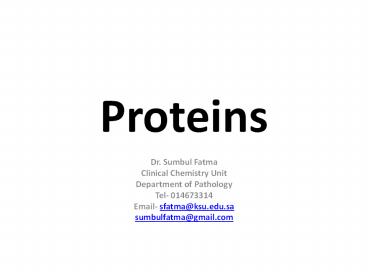Proteins - PowerPoint PPT Presentation
Title:
Proteins
Description:
Proteins Dr. Sumbul Fatma Clinical Chemistry Unit Department of Pathology Tel- 014673314 Email- sfatma_at_ksu.edu.sa sumbulfatma_at_gmail.com What are proteins? – PowerPoint PPT presentation
Number of Views:196
Avg rating:3.0/5.0
Title: Proteins
1
Proteins
- Dr. Sumbul Fatma
- Clinical Chemistry Unit
- Department of Pathology
- Tel- 014673314
- Email- sfatma_at_ksu.edu.sa
- sumbulfatma_at_gmail.com
2
What are proteins?
- Proteins are polymers of amino acids joined
together by peptide bonds
3
Peptide Bond (amide bond)
4
- Each amino acid in a chain makes two peptide
bonds - The amino acids at the two ends of a chain
make only one peptide bond - The aa with a free amino group is called amino
terminus or N-terminus - The aa with a free carboxylic group is called
carboxyl terminus or C-terminus
5
Peptides
- Amino acids can be polymerized to form chains
- 2 aa- dipeptide
- 3-?
- 4- ?
- Few ( 10)- oligo peptide
- more- polypeptide
6
Primary Structure
- It is the linear sequence of amino acids
- Covalent bonds
- Peptide bond
- Dislphide bond
- (if any)
7
Secondary Structure
- It is the local three-dimensional arrangement of
a polypeptide backbone - Excluding the conformations (3D arrangements) of
its side chains
8
a Helix
- a helix is right-handed
- It has 3.6 amino acid residues per turn
- Stabilized by hydrogen bonding
- Between 1st carboxylic group and 4th amino group
- The side chains point outward and downward from
the helix - The core of the helix is tightly packed and its
atoms are in van der Waals contact
9
(No Transcript)
10
b Sheets
- Two or more polypeptide chains make hydrogen
bonding with each other - Also called pleated sheets because they appear
as folded structures with edges
11
Antiparallel ß sheets
- Two or more hydrogen-bonded polypeptide chains
run in opposite direction - Hydrogen bonding is more stable
12
Parallel ß sheets
- Two or more hydrogen-bonded polypeptide chains
run in the same direction - Hydrogen bonding is less stable (distorted)
13
Collagen a triple helix
- A fibrous protein
- Part of connective tissues bone, teeth,
cartilage, tendon, skin, blood vessels - Contains three left-handed coiled chains (not a
helix) - Three residues per turn
14
Proline in collagen
- Rich in proline amino acid
- Proline prevents collagen chains to form a-helix
because - It does not have back bone amino group (it is
cyclic) - Therefore hydrogen bonding within the helix is
not possible
15
Non-standard amino acids in collagen
- Proline is converted to 4-hydroxyprolyl residue
by prolyl hydroxylase enzyme - The enzyme requires vitamin C for its function
16
Collagen diseases
- Scurvy due to vitamin C deficiency
- Ehlers-Danlos syndromes hyperextensibility of
joints and skin - Mutations in collagen gene
17
Other Secondary Structures
- Turns (reverse turns)
- Loops
- ? bends
- Random coils
18
Supersecondary structures or motifs
- ß a ß motif a helix connects two ß sheets
- ß hairpin reverse turns connect antiparallel ß
sheets - a a motif two a helices together
- ß barrels rolls of ß sheets
19
ß barrels
20
Tertiary Structure
- It is the 3-d structure of an entire polypeptide
chain including side chains - It includes the folding of secondary structure (a
helix and ß sheets) and side chains - Helices and sheets can be combined to form
tertiary structure
21
Domains
- Polypeptide chains (gt200 amino acids) fold into
two or more clusters known as domains - Domains are functional units that look like
globular proteins - Domains are parts of protein subunits
22
Quaternary Structure
- Many proteins contain two or more polypeptide
chains - Each chain forms a three-dimensional structure
called subunit - It is the 3D arrangement of different subunits of
a protein
23
Hemoglobin
- Hemoglobin is a globular protein
- A multisubunit protein is called oligomer
- Composed of a 2 ß 2 subunits (4 subunits)
- Two same subunits are called protomers
24
(No Transcript)
25
Forces that stabilize protein structure
- Hydrophobic effect
- Nonpolar groups to minimize their contacts with
water - Nonpolar side chains are in the interior of a
protein - Hydrogen bonding
- A weak electrostatic bond between one
electronegative atom like O or N and a hydrogen
atom - Electrostatic interactions (ion pairing)
- Between positive and negative charges
- van der Waals forces (weak polar forces)
- Weak electrostatic interactions between neutral
molecules
26
Protein denaturation
- Denaturation A process in which a protein looses
its native structure - Factors that cause denaturation
- Heat disrupts hydrogen bonding
- Change in pH alters ionization states of aa
- Detergents interfere with hydrophobic
interactions - Chaotropic agents ions or small organic
molecules that disrupt hydrophobic interactions
27
Protein Misfolding
- Every protein must fold to achieve its normal
conformation and function - Abnormal folding of proteins leads to a number of
diseases in humans - Alzheimers disease
- ß amyloid protein is a misfolded protein
- It forms fibrous deposits or plaques in the
brains of Alzheimers patients
28
- Creutzfeldt-Jacob or prion disease
- Prion protein is present in normal brain tissue
- In diseased brains, the same protein is misfolded
- Therefore it forms insoluble fibrous aggregates
that damage brain cells































